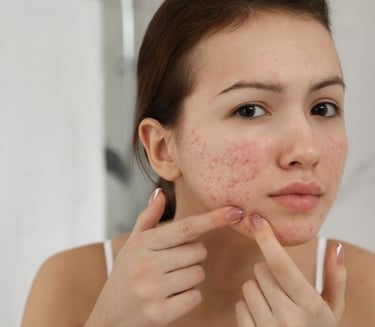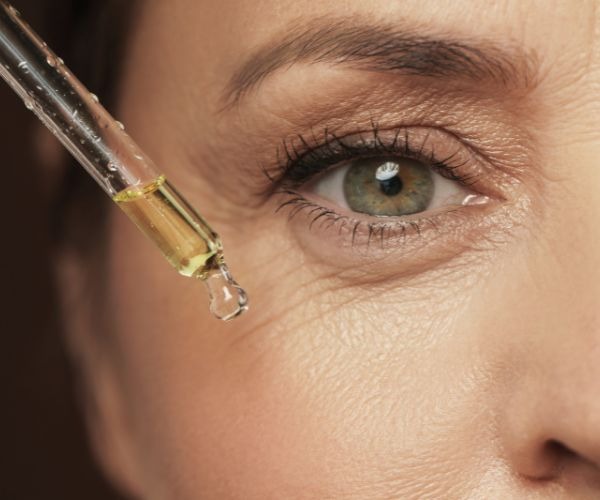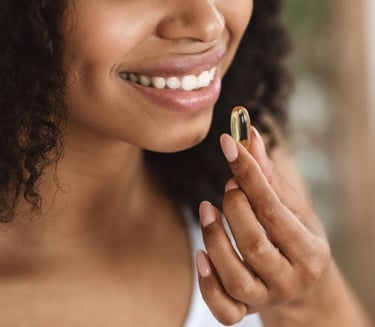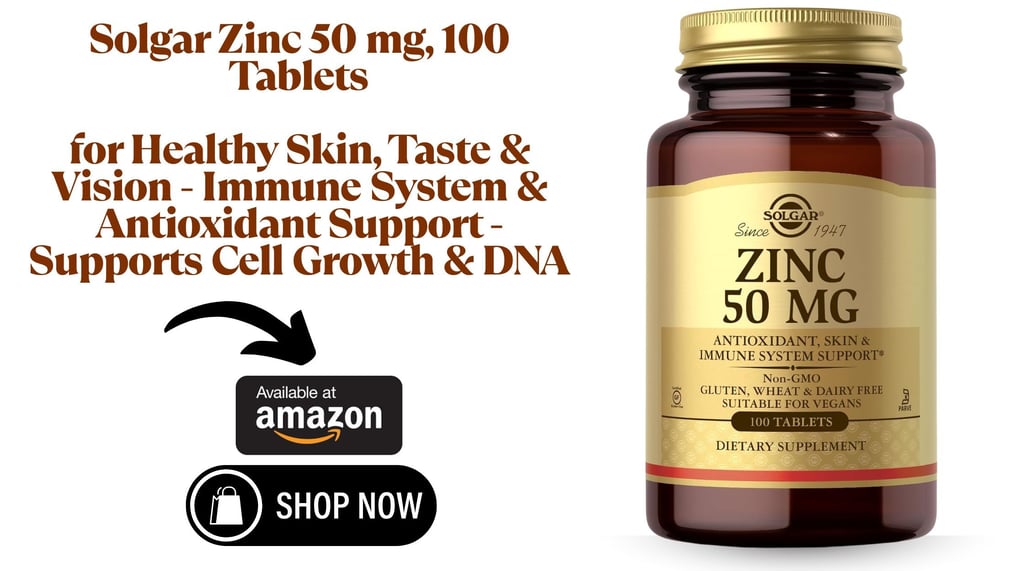Natural Remedies for Hormonal Skin Problems: Simple Solutions for Women [Updated 2025]
Find the latest natural remedies for hormonal skin problems. Get straightforward advice to balance your skin and boost your confidence.
WOMEN'S BEAUTY HEALTH
Shari Smith
7/21/202513 min read
As an Amazon affiliate, we earn commissions at no extra cost to you if you click our links and make a purchase.


If your skin seems to act up around your period, pregnancy, or menopause, you’re not alone. Hormonal changes can trigger breakouts, redness, oiliness, or even dry patches that feel hard to manage.
Many women deal with these shifts at different stages of life, often feeling frustrated by stubborn symptoms.
There’s a growing interest in natural remedies for hormonal skin problems, and for good reason. You want solutions that are gentle, safe, and actually work without harsh chemicals.
In this guide, you’ll find trusted, simple ways to support your skin with natural options that fit into everyday routines.
Understanding Hormonal Skin Problems in Women
If you’ve ever noticed stubborn breakouts, red patches, or unpredictable skin changes that follow your body’s cycles, hormones could be to blame.
Hormonal imbalances often act behind the scenes, sending your skin on a rollercoaster ride that can feel both confusing and frustrating.
Let’s look closer at why these shifts happen, how to recognize them, and which conditions arise when your hormones and skin aren’t playing nicely together.


Common Causes of Hormonal Skin Issues
Women’s bodies run on a unique hormonal rhythm, and even small changes can leave skin feeling unsettled. Several life stages and stressors can stir up these hormones and lead to the need for natural remedies for hormonal skin problems.
Here are key triggers:
Puberty: Your skin may suddenly become oily, blemish-prone, or sensitive when sex hormones surge for the first time. It’s a common reason for teenage acne.
Menstrual Cycle: Ever notice breakouts on your chin or jawline before your period? That’s the work of fluctuating estrogen and progesterone levels, which can increase oil production.
Pregnancy: Hormones shift dramatically when you’re expecting, often causing melasma (brown spots) or pregnancy acne.
Menopause: Dropping estrogen levels can leave skin dry, thin, and more prone to irritation and redness during this stage.
Stress: Cortisol, your stress hormone, can spike oil production and contribute to inflammation, paving the way for acne or eczema.
Underlying Health Conditions: Problems like polycystic ovary syndrome (PCOS), thyroid imbalance, or diabetes change hormone levels. This can make skin conditions more severe or harder to control.
Hormonal skin problems can affect anyone, but women often face more pronounced changes due to natural life cycles.
How to Identify Hormonal Skin Problems
Hormonal imbalances don’t just affect emotions or energy — they show up on your skin, too. Spotting the clues can help you find the right natural remedies for hormonal skin problems and feel more in control.
These are some signs that hormone swings might be messing with your skin:
Adult Acne: Breakouts or cystic pimples along the jaw, chin, or cheeks, especially in your 20s, 30s, or 40s, often point to hormone-driven triggers.
Melasma (The “Mask of Pregnancy”): Patches of darker skin, often on the cheeks, forehead, or upper lip. More common during pregnancy or with birth control use.
Eczema Flare-ups: Itchy, red, or inflamed patches can worsen with hormonal shifts or stress.
Sudden Changes in Oiliness or Dryness: Skin can swing from greasy to dry or flaky without warning, especially at certain times of the month.
Redness and Sensitivity: Hormonal changes can leave your skin feeling hot, flushed, or easily irritated.
What makes these issues different from regular acne or dryness?
The timing and pattern matter. Hormonal skin problems often start or get worse at predictable times (such as right before your period, during pregnancy, or around menopause).
Noticing this pattern can help you connect the dots and choose targeted, natural steps for relief.
When you spot these telltale signs, you’re already one step closer to treating your skin from the inside out.
Identifying the root cause helps you find what actually works—without guesswork or harsh chemicals.
Dietary and Lifestyle Changes for Hormonal Balance
Eating well and making simple changes to your daily habits can help bring your hormones back into balance.
The foods you choose and the way you care for your body don’t just affect your energy or mood.
They can make a real difference in the way your skin looks and feels, too.
Many women see clearer, calmer skin when they focus on natural remedies for hormonal skin problems that start with what goes on their plate and how they spend their days.


Foods that Support Hormone Health
Your everyday meals can be your best ally for balanced hormones. Some foods help support your body’s natural rhythms, feed your skin, and ease flare-ups.
Here are key foods to add to your routine:
Leafy greens (like spinach, kale, and Swiss chard): Packed with magnesium, folate, and fiber, these greens help your body process hormones and fight inflammation.
Healthy fats (think avocado, olive oil, nuts, and wild fish): These foods provide omega-3s, which keep skin glowing and support hormone production.
Seeds (such as flax, chia, pumpkin, and sunflower): Flax seeds contain lignans that can help balance estrogen, while pumpkin and sunflower seeds are rich in zinc and vitamin E for skin repair.
Colorful veggies (like carrots, sweet potatoes, and bell peppers): Full of antioxidants that protect your cells and support hormone detox.
Fermented foods (including yogurt with live cultures, sauerkraut, and kimchi): Help balance your gut, which plays a key role in hormone health and clearer skin.
Whole grains and beans: Oats, brown rice, lentils, and chickpeas give steady energy and fiber that supports healthy blood sugar, helping to keep hormones steady.
Try to fill at least half your plate with plants, aim for healthy fats at each meal, and rotate your seeds for the best benefit. These habits can be easy natural remedies for hormonal skin problems that you work into any lifestyle.
Avoiding Triggers: Foods and Habits that Worsen Problems
Certain foods and daily habits can throw your hormones off, showing up quickly as skin breakouts, oiliness, or redness. Knowing what to look out for makes it easier to avoid those triggers and keep your skin on track.
Watch out for these common culprits:
High sugar and refined carbs: Candy, soda, white bread, and pastries spike your blood sugar fast, which can mess with hormones and lead to breakouts.
Dairy products: Some women notice more flare-ups and stubborn acne with regular dairy (like milk, cheese, or ice cream) due to natural hormones in milk or effects on insulin.
Processed foods: Chips, fast food, frozen meals, and packaged snacks usually contain unhealthy fats and additives that create inflammation.
Excess caffeine and alcohol: These can disrupt sleep, stress out your nervous system, and throw off your hormone balance.
Skipping meals or restrictive diets: Not eating enough or missing meals may disrupt your blood sugar and stress hormones, which can make skin symptoms worse.
Lack of sleep: When you skimp on sleep, stress hormones rise, and your body struggles to repair itself, often showing up as dull or inflamed skin.
Chronic stress: High-stress lifestyles keep cortisol high, which is a major trigger for hormone swings and skin flare-ups.
If you’re trying to use natural remedies for hormonal skin problems, start by taking a close look at what you eat and your daily routines.
Avoiding the obvious culprits and making small swaps can open the door to better hormone health and clearer skin.
Topical Natural Remedies for Hormonal Skin Problems
When you notice your skin flaring up, it can make you feel self-conscious and frustrated.
Many women want skin care that works without irritation or heavy chemicals.
The good news is, you have options that soothe, calm, and balance your skin with the help of plants, minerals, and natural oils.
These topical natural remedies for hormonal skin problems use simple ingredients to manage symptoms where you need it most.


Herbs and Botanical Extracts for the Skin
Plant-powered remedies shine when your skin is in distress. Many herbs help reduce redness, control bacteria, and calm breakouts triggered by hormonal swings.
These favorites are easy to find and add to your routine:
Tea tree oil: This oil is famous for targeting blemishes, thanks to its antibacterial and anti-inflammatory effects. Dab a little diluted tea tree oil onto pimples with a cotton swab.
Calendula: Known for speeding skin repair and calming irritation, calendula creams or ointments are great for red, inflamed patches and hormonal eczema.
Evening primrose oil: Rich in essential fatty acids, this oil tackles dry skin and supports repair. Try a drop or two as a gentle moisturizer on flaky, irritated spots.
Licorice extract: This herbal extract helps fade dark marks and calms sensitive or inflamed skin. Serums or creams with licorice are great for melasma or redness.
Chamomile: Known for its soothing edge, chamomile reduces itchiness and swelling. Use chamomile-infused creams or face sprays whenever your skin feels stressed.
Herbal extracts are gentle but effective. Patch-test new products to avoid irritation and look for simple ingredient lists.
Natural Masks and DIY Skincare Treatments
Homemade skin care can be both soothing and budget-friendly. Using natural remedies for hormonal skin problems means you can tap into what you already have in your kitchen.
These ingredients are especially helpful for sudden breakouts or sensitivity:
Clay masks: Bentonite or kaolin clay helps absorb oil, clear out pores, and reduce shine. Mix with water (or plain yogurt for extra soothing) and apply for 10-15 minutes before rinsing.
Honey masks: Raw honey acts as a natural antibacterial and hydrates parched skin. Apply a thin layer as a mask or dab directly onto breakouts.
Oatmeal-based remedies: Finely ground oats mixed with water or milk can calm itching, redness, and irritation. Use as a simple scrub or soothing face mask.
For quick relief:
Mix two tablespoons of clay, honey, or oatmeal with a little water.
Smooth onto clean skin.
Rinse gently with warm water after 10-15 minutes.
Your skin will feel clearer and calmer—without the risk of harsh chemicals.
Essential Oils for Hormonal Balance and Skin Health
Essential oils can do more than smell good; they offer real benefits for your skin if used correctly.
They need to be diluted with a carrier oil (like jojoba or sweet almond) to prevent irritation. A few drops go a long way.
Top choices for hormonal skin support include:
Lavender oil: This oil calms angry skin, eases redness, and soothes breakouts. Add two drops to a teaspoon of carrier oil, then pat gently onto troubled spots.
Geranium oil: Known to balance oil production and promote clear skin, geranium is great for hormone-linked breakouts.
Clary sage oil: This oil may help regulate oiliness and calm inflammation, making it a solid choice for acne-prone skin.
Remember:
Always dilute essential oils, as pure oils can damage your skin.
Patch-test on your inner arm before applying to your face.
Avoid sensitive areas like eyes and lips.
Using these oils in your nightly routine can help support clearer skin and keep hormone-triggered flare-ups under control, all with a gentle, natural approach.
Supplements and Herbal Remedies for Hormonal Skin Issues
Natural remedies for hormonal skin problems can include more than just what goes on your plate or your face.
Many women look to vitamins, minerals, and herbs to get relief from persistent breakouts, oily skin, or stubborn melasma.
If you want to support your hormones from within, smart supplements and calming teas might be the missing step in your routine.


Popular Supplements for Hormonal Balance
Certain supplements can help balance hormones and give your skin a chance to heal. While you should always check with your doctor before starting anything new, many women find the following nutrients make a real difference:
Zinc
Zinc is well-known for fighting breakouts and calming inflamed skin. It can help regulate sebum production and reduce the severity of acne linked to hormone shifts.
Typical dose: 15-30 mg a day, taken with food.
Choose zinc picolinate or zinc gluconate for better absorption.
Vitamin B6 (Pyridoxine)
Vitamin B6 can be especially helpful before your period when hormones swing and skin acts up. It supports progesterone balance, which may lead to fewer breakouts and less bloating.
Common dose: 25-50 mg a day.
Look for B-complex supplements to round out your vitamin support.
Omega-3 Fatty Acids
Found in fish oil (or plant sources like flaxseed), omega-3s calm inflammation and support skin’s natural barrier. They may also help reduce redness, dryness, or sensitivity caused by hormone changes.
Aim for 1,000-2,000 mg of combined EPA/DHA daily.
Plant-based options work too if you avoid fish.
Magnesium
Magnesium calms nerves, supports sleep, and helps balance cortisol (the stress hormone). Steady magnesium levels may ease PMS breakouts and even out oily skin.
Suggested dose: 200-400 mg per day, usually at night.
Look for chelated forms like magnesium glycinate for fewer tummy troubles.
When you pick supplements, quality matters as much as quantity. Stick to trusted brands, avoid mega-doses, and keep your doctor in the loop—especially if you have other health conditions or take medication.
These nutrients can be a powerful piece of your plan for natural remedies for hormonal skin problems, supporting clearer skin by working from within.
Herbal Teas and Tinctures
Herbal teas and tinctures can give gentle, daily support to your hormones. Unlike pills, you can make a soothing ritual out of your tea time or take tinctures by the drop.
Here are some top choices women turn to for hormone support and happier skin:
Spearmint Tea
Spearmint tea is highly regarded for women dealing with hormonal acne, especially related to high androgen levels (like with PCOS). Drinking 1-2 cups daily may lower unwanted hair and calm breakouts. Plus, it’s refreshing and easy to find.
Chasteberry (Vitex agnus-castus)
Chasteberry is a classic remedy for cycle-related breakouts and PMS symptoms. It works by balancing the pituitary gland, which controls other reproductive hormones.
Take as a tincture or standardized capsule, often for 2-3 months for full benefits.
It’s best to start with a low dose and see how your body reacts.
Green Tea
Green tea is full of antioxidants that help protect skin cells and balance oil. Drinking green tea daily may reduce inflammation, boost your natural glow, and offer a subtle hormone-balancing effect. You can also use matcha for a stronger punch.
These teas and tinctures fit easily into most routines, making them a simple add-on to your day.
When you use herbs for natural remedies for hormonal skin problems, start slow, listen to your body, and give them time to work. A warm mug might be just what your skin (and mind) needs.
Amazing Results
I am an African American female and have suffered from daily to weekly breakouts for decades.
After consuming this tea for about 2 months straight, I noticed that my skin was breaking out less frequently.
I continued my skincare regimen for washing and moisturizing, and this tea was the added bonus."
-Verified Customer Review
Lifestyle Practices to Enhance Results from Natural Remedies
Natural remedies for hormonal skin problems often work best when you back them up with healthy daily habits.
Sometimes, simple changes in your routine help your body rebalance faster, making your skin look brighter and clearer.
By tuning into stress, sleep, and movement, you set the stage for natural solutions to give you stronger results.


Stress Management and Sleep
Stress and sleep go hand in hand with hormone balance. High stress spikes cortisol, which can play havoc on your complexion, spark new breakouts, and make redness hang on longer.
Skimping on sleep does the same thing—your body doesn’t get the reset it needs, and your skin misses out on its repair time.
If you feel on edge or have trouble winding down, try these easy steps:
Carve out calm moments: Even ten minutes of quiet each day can make a difference. Meditation apps (or simply sitting with your eyes closed and deep breathing) help lower tension. Deep breathing slows your heart rate, sending a signal to your system that it’s safe to power down.
Build a predictable bedtime: Sleep likes routine. Turn screens off early, dim the lights, and find a calming habit—like reading or gentle stretches. Going to bed and waking up at the same time teaches your hormones when to work and when to rest.
Limit caffeine after noon: Caffeine sticks around in your system. Switching to herbal tea or water in the afternoon gives your body a better shot at getting real rest.
Jot down thoughts before bed: Stressful thoughts love to pop up when you hit the pillow. Keeping a small notebook nearby lets you get your worries out of your head, setting your mind up for sleep.
Try guided relaxation: Audio exercises and sleep stories calm the mind and get you ready to drift off without tossing and turning.
Better sleep and lower stress show up as more balanced hormones, fewer flare-ups, and skin that looks less angry and more even-toned.
Exercise and Movement
Natural remedies for hormonal skin problems are stronger when you keep your body moving.
Regular exercise doesn’t mean sweating buckets for hours—a bit of activity each day offers lasting benefits for hormone balance and skin health.
Some simple fitness choices fit any lifestyle:
Gentle yoga: Yoga helps smooth out stress, lowers cortisol, and improves circulation. This keeps skin cells happy and inflammation down. Aim for a short flow or even a few stretches in the morning or before bed.
Daily walks: Getting outdoors helps your mood, balances hormones, and gives your skin a little dose of sunlight (think vitamin D in safe amounts). Start with 20 minutes and add more as it feels good.
Strength training: Lifting light weights or using bands keeps your muscles and metabolism humming. Stronger muscles support steady hormones, which can help with everything from oily skin to PMS breakouts.
To stay motivated, combine movement with things you love—a walk with a friend or music during yoga can make all the difference. Consistency matters more than intensity.
When you make exercise a natural part of your days, your skin will often thank you with fewer breakouts, calmer changes, and a healthy glow.
Pair these habits with your favorite natural remedies for hormonal skin problems to see changes that last. Small steps add up to big results you can see and feel.
Why the NordicTrack T Series Treadmill is a Game-Changer
When life gets busy or the weather doesn’t cooperate, having a treadmill at home like the NordicTrack T Series ensures you never miss your 45-minute walk.
This treadmill isn’t just about walking; it’s like having a personal walking coach in your living room.
Conclusion
Building healthy skin takes more than a quick fix. Consistent habits, a balanced diet, gentle topical care, and daily stress relief work best together.
Natural remedies for hormonal skin problems can bring real change when you use them as part of a daily routine and stay patient with the process.
This journey is unique for every woman. If your symptoms feel overwhelming or slow to improve, reach out to a healthcare provider for extra support. You deserve to feel confident in your skin and your health.















